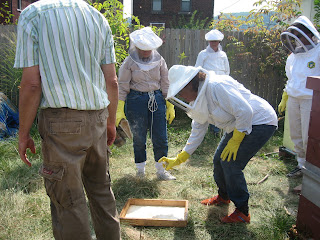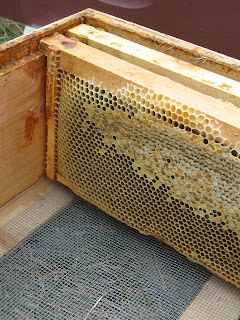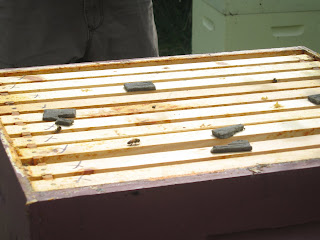Sunday, September 20, 2009
Fall Extraction, Part I
We were lucky enough to have a couple supers of fall honey on top of our one overwintered hive in Hazelwood. We feel very lucky as several of our beekeepers have noted a low fall flow this season. These gals have really been packing it in.
 In an urban area we are apt to use Bee Quick to clear the supers. Our students sprayed it onto the fume cover, and in the hot sun, the bees moved down into their hive bodies.
In an urban area we are apt to use Bee Quick to clear the supers. Our students sprayed it onto the fume cover, and in the hot sun, the bees moved down into their hive bodies.
 Then, the frames are easily moved without bees into a screened super to be transported to the kitchen for extraction.
Then, the frames are easily moved without bees into a screened super to be transported to the kitchen for extraction.

Fall Extraction, Part II
At the kitchen, Joe Z., demonstrated how to uncap with several different knives.
One of our students, Roberta, tests Joe's description of the knives.
In the second video, note that Joe points out that up to 10% of the honey can be in the capings, which is why you want to collect those and harvest that honey as well.
Steve had been kind enough to lend us his automatic extractor (though there are plans in the works for a bike powered extractor). The honey runs out from the uncapped centrifugal force as the frames spin.

The honey flows out of the extractor through a spout on the side near the bottom. The honey is strained, but not filtered.
One of our students, Roberta, tests Joe's description of the knives.
In the second video, note that Joe points out that up to 10% of the honey can be in the capings, which is why you want to collect those and harvest that honey as well.
Steve had been kind enough to lend us his automatic extractor (though there are plans in the works for a bike powered extractor). The honey runs out from the uncapped centrifugal force as the frames spin.
The honey flows out of the extractor through a spout on the side near the bottom. The honey is strained, but not filtered.
Back to Blogging
We've been very busy this summer and have fallen behind in our blogging duties. But, I hope that doesn't mean that you haven't been following our presence at all the events around town. Check out the events page on our website to see all the things we've been up to in the past months. We just had our ninth class which involved a honey extraction from our hives in Hazelwood (a blog entry to soon follow). Going forward, we hope to be more diligent in posting to the blog with pictures from our classes and events.
At this point in the season, we are checking on our hives to make sure they are healthy heading into winter. To do this, we've reduced their entrances and installed mouse guards.
 We've also started feeding sugar water in hive top feeders to help build up stores for the winter. Many beekeepers have had a very light fall honey flow. Additionally, we've treated for mites throughout the season with powdered sugar and apiguard. The frames are marked with an X to ensure that we do not harvest honey stored during the treatment.
We've also started feeding sugar water in hive top feeders to help build up stores for the winter. Many beekeepers have had a very light fall honey flow. Additionally, we've treated for mites throughout the season with powdered sugar and apiguard. The frames are marked with an X to ensure that we do not harvest honey stored during the treatment.
 To help accomplish these tasks, several of our class members have volunteered as stewards to watch the hives as the move into winter.
To help accomplish these tasks, several of our class members have volunteered as stewards to watch the hives as the move into winter.
At this point in the season, we are checking on our hives to make sure they are healthy heading into winter. To do this, we've reduced their entrances and installed mouse guards.
Subscribe to:
Comments (Atom)
